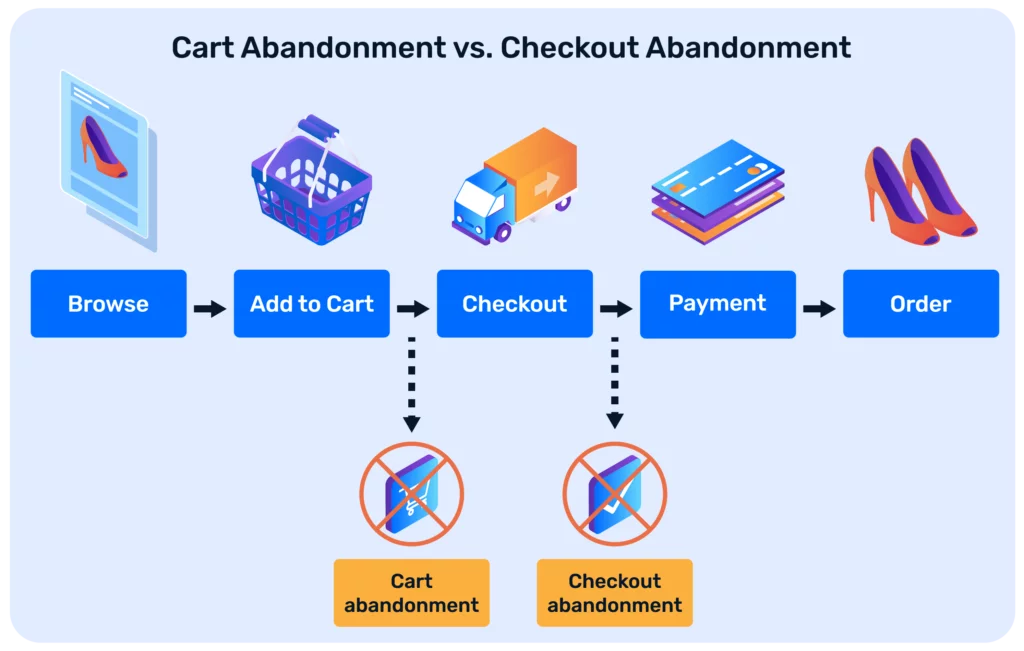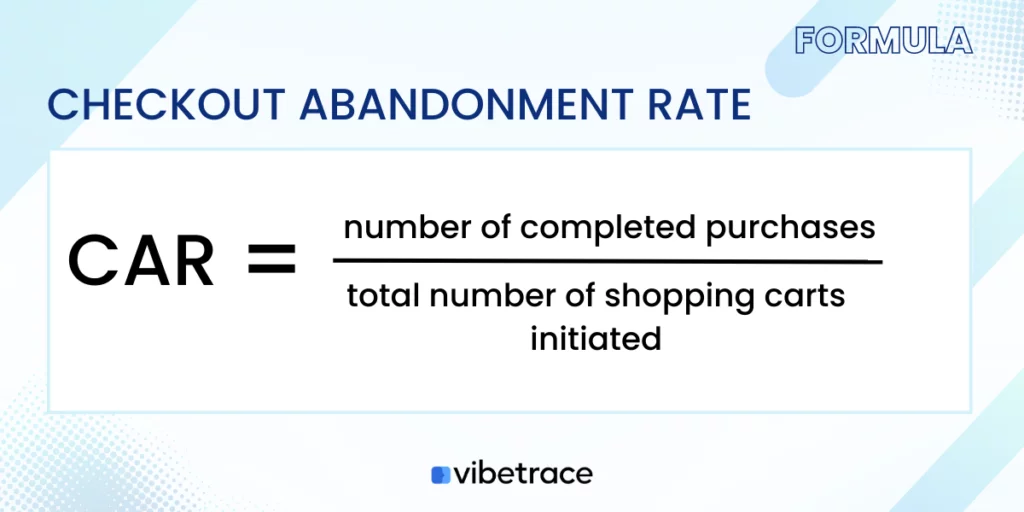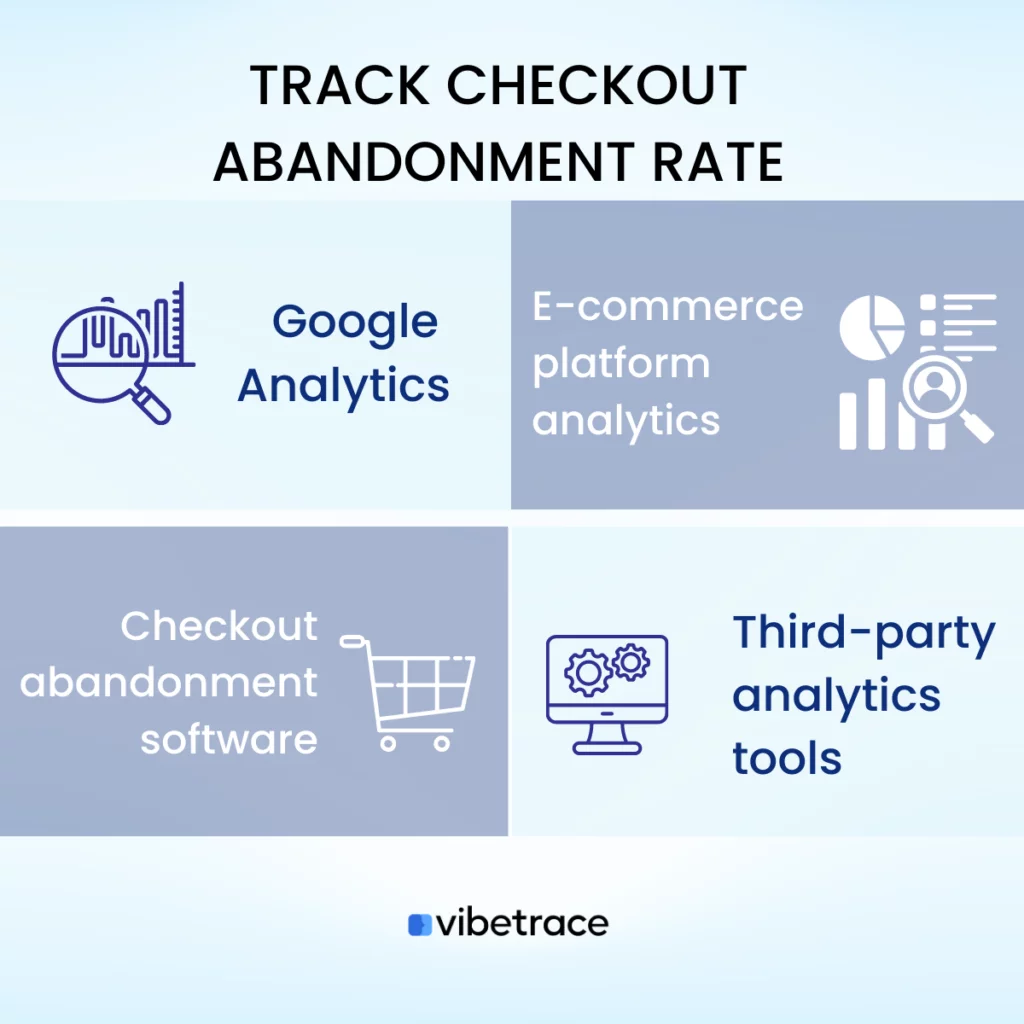The Checkout Abandonment Rate is a crucial metric that reflects lost sales and revenue for eCommerce businesses.
It can be frustrating for any business to see customers abandon their checkout process due to various reasons, including hidden fees, high shipping costs, complex checkout procedures, and high tax and service fees.
To resolve this and to determine how effective and seamless for the customer the checkout process is, it is advisable to track the checkout abandonment rate.
This metric can provide insights into what changes need to be made to encourage customers to complete their purchases.
What is Checkout Abandonment Rate?
Definition of Conversion Rate
Checkout abandonment rate refers to the percentage of online shoppers who add items to their cart but then leave the website before completing the purchase even after they have already entered their information.
In other words, these shoppers abandon their shopping carts during the checkout process.
Reducing checkout abandonment is an important goal for online retailers, and there are several strategies that can help.
These include:
- simplifying the checkout process
- providing clear information about shipping costs and delivery times
- offering guest checkout options
- ensuring website security
- providing multiple payment options.

Checkout Abandonment Rate vs Cart Abandonment Rate
Checkout abandonment rate and cart abandonment rate are two metrics that are often confused with each other in the world of e-commerce.
Cart abandonment rate refers to the percentage of users who add items to their cart but leave the website without completing the purchase.
This can happen at any point during the shopping journey, such as when the user is browsing, comparing prices, or even during the checkout process.
Checkout abandonment rate, on the other hand, specifically measures the percentage of users who abandon the checkout process after initiating it.
This means that they have already reached the point where they have entered their shipping and payment information but have not completed the purchase.
Learn more about Cart abandonment here.
Both abandonments are really important, and can be recovered using marketing automation.
Checkout Abandonment Rate Formula

To calculate the checkout abandonment rate, the number of completed purchases is divided by the total number of shopping carts initiated.
The resulting percentage represents the proportion of shoppers who started the checkout process but did not complete their purchase.
Do you like this article?
Join our CX for Retail dedicated newsletter!

Stay connected to what’s really important to optimize your digital revenues.
By clicking the button, you accept our Terms & Conditions. Also you will need to confirm your email address.
How to track Checkout Abandonment Rate?
There are several tools that can be used to track your business checkout abandonment rate. Here are some options:

Google Analytics: Google Analytics is a free web analytics tool for tracking website traffic and activity, such as checkout abandonment. You may track the number of initiated checkouts and completed purchases, as well as the checkout abandonment rate, by setting up tracking goals and funnels.
E-commerce platform analytics: Many e-commerce platforms, such as Shopify and Magento, include analytics tools that can be used to track the rate of checkout abandonment. These tools often include information on the number of initiated checkouts, completed transactions, and abandoned carts, as well as information on the precise pages or phases in the checkout process where customers are abandoning their carts.
Checkout abandonment software: There are several software solutions available that are specifically designed to track checkout abandonment and provide insights into why shoppers are abandoning their carts. These tools typically integrate with e-commerce platforms and provide real-time alerts and reports on abandoned carts, as well as recommendations for improving the checkout process.
Third-party analytics tools: In addition to Google Analytics, there are several third-party analytics tools available that can be used to track checkout abandonment rate. These tools may offer more advanced features and customization options, but may also come with a higher cost.
No matter which tool is used to track your business checkout abandonment rate, it is important to regularly review and analyze the data to identify trends and opportunities for improvement.
How often should you check Checkout Abandonment Rate?
It is recommended to check the checkout abandonment rate regularly, at least once a week, to track any changes and identify potential issues. You can quickly identify any changes or trends that may be impacting your sales by monitoring the checkout abandonment rate regularly,
In addition to checking the overall checkout abandonment rate, it can also be helpful to look at specific pages or steps in the checkout process that may be causing the most abandonment.
For example, if a large number of shoppers are abandoning their carts on the payment page, it may indicate that there is a problem with the payment processing system that needs to be addressed.
Checkout Abandonment Rate Calculator
Do you want to calculate your checkout abandonment rate? Use our simple calculator below.
Simple Checkout Abandonment Rate Calculator
Number of finished purchases:
Number of initiated checkouts:
Checkout Abandonment Rate
= ?
Important Things about Checkout Abandonment Rate
Here are some important things to keep in mind about the checkout abandonment rate:
Checkout abandonment is common: Research shows that the average checkout abandonment rate for e-commerce websites is around 70%. This means that a large percentage of shoppers who initiate the checkout process does not complete their purchase.
High abandonment rates can indicate problems: A high checkout abandonment rate can be a sign of problems with the checkout process, such as unexpected fees, complex or lengthy forms, slow page load times, or technical issues.
Checkout abandonment rate varies by industry: The checkout abandonment rate can vary depending on the industry, with some industries experiencing higher rates than others. For example, fashion and travel websites tend to have higher checkout abandonment rates than electronics or home goods websites.
Mobile checkout abandonment can be higher: Mobile shoppers may be more likely to abandon their carts than desktop users, due to smaller screens, slower page load times, and other factors. Retailers should ensure that their checkout process is optimized for mobile users to reduce abandonment rates.
Checkout optimization can improve conversion rates: You can reduce abandonment rates and increase conversions by optimizing your checkout process. This can include simplifying the checkout process, providing clear information on fees and shipping times, offering guest checkout options, and optimizing for mobile users.
Metrics related to Checkout Abandonment Rate
Here are six metrics related to checkout abandonment rate:
Revenue per Visitor
The amount of revenue generated by each visitor to the website.
Average Order Value
Purchase Frequency
The measure of how often customers make purchases from a business.
If you are looking for an email marketing platform that is perfect for your business, consider Vibetrace on your list.
Vibetrace can help you send automated emails to customers who have left items in their cart without completing their purchase. These emails can include a reminder of the items left in the cart and a call-to-action to complete the checkout process.
In fact, Vibetrace can also help you in reducing the checkout abandonment rate by implementing various strategies such as providing personalized messaging, and A/B testing to optimize your approach.

